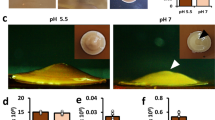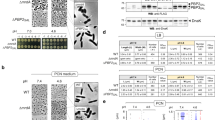Abstract
Bacteria have evolved complex systems to maintain consistent cell morphologies. Nevertheless, in certain circumstances, bacteria alter this highly regulated process to transform into filamentous organisms. Accumulating evidence attributes important biological roles to filamentation in stressful environments, including, but not limited to, sites of interaction between pathogenic bacteria and their hosts. Filamentation could represent an intended response to specific environmental cues that promote survival amidst the threats of consumption and killing.
This is a preview of subscription content, access via your institution
Access options
Subscribe to this journal
Receive 12 print issues and online access
$209.00 per year
only $17.42 per issue
Buy this article
- Purchase on Springer Link
- Instant access to full article PDF
Prices may be subject to local taxes which are calculated during checkout




Similar content being viewed by others
References
Duguay, A. R. & Silhavy, T. J. Quality control in the bacterial periplasm. Biochim. Biophys. Acta 1694, 121–134 (2004).
Siu, L. K. Antibiotics: action and resistance in Gram-negative bacteria. J. Microbiol. Immunol. Infect. 35, 1–11 (2002).
Chen, K., Sun, G. W., Chua, K. L. & Gan, Y. H. Modified virulence of antibiotic-induced Burkholderia pseudomallei filaments. Antimicrob. Agents Chemother. 49, 1002–1009 (2005).
Young, K. D. The selective value of bacterial shape. Microbiol. Mol. Biol. Rev. 70, 660–703 (2006).
Zaritsky, A. On dimensional determination of rod-shaped bacteria. J. Theor. Biol. 54, 243–248 (1975).
Harry, E., Monahan, L. & Thompson, L. Bacterial cell division: the mechanism and its precison. Int. Rev. Cytol. 253, 27–94 (2006).
Rothfield, L., Justice, S. & Garcia-Lara, J. Bacterial cell division. Annu. Rev. Genet. 33, 423–448 (1999).
Foxman, B. Epidemiology of urinary tract infections: incidence, morbidity, and economic costs. Dis. Mon. 49, 53–70 (2003).
Mulvey, M. A. et al. Induction and evasion of host defenses by type 1-piliated uropathogenic Escherichia coli. Science 282, 1494–1497 (1998).
Justice, S. S. et al. Differentiation and developmental pathways of uropathogenic Escherichia coli in urinary tract pathogenesis. Proc. Natl Acad. Sci. USA 101, 1333–1338 (2004).
Justice, S. S., Hunstad, D. A., Seed, P. C. & Hultgren, S. J. Filamentation by Escherichia coli subverts innate defenses during urinary tract infection. Proc. Natl Acad. Sci. USA 103, 19884–19889 (2006).
Leroy, M. et al. Multiple consecutive lavage samplings reveal greater burden of disease and provide direct access to the nontypeable Haemophilus influenzae biofilm in experimental otitis media. Infect. Immun. 75, 4158–4172 (2007).
Jurcisek, J. A. & Bakaletz, L. O. Biofilms formed by nontypeable Haemophilus influenzae in vivo contain both double-stranded DNA and type IV pilin protein. J. Bacteriol. 189, 3868–3875 (2007).
Belas, R. & Suvanasuthi, R. The ability of Proteus mirabilis to sense surfaces and regulate virulence gene expression involves FliL, a flagellar basal body protein. J. Bacteriol. 187, 6789–6803 (2005).
Belas, R., Manos, J. & Suvanasuthi, R. Proteus mirabilis ZapA metalloprotease degrades a broad spectrum of substrates, including antimicrobial peptides. Infect. Immun. 72, 5159–5167 (2004).
Piao, Z., Sze, C. C., Barysheva, O., Iida, K. & Yoshida, S. Temperature-regulated formation of mycelial mat-like biofilms by Legionella pneumophila. Appl. Environ. Microbiol. 72, 1613–1622 (2006).
Ogawa, M., Takade, A., Miyamoto, H., Taniguchi, H. & Yoshida, S. Morphological variety of intracellular microcolonies of Legionella species in Vero cells. Microbiol. Immunol. 45, 557–562 (2001).
Chauhan, A. et al. Mycobacterium tuberculosis cells growing in macrophages are filamentous and deficient in FtsZ rings. J. Bacteriol. 188, 1856–1865 (2006).
Abrahams, G. L. & Hensel, M. Manipulating cellular transport and immune responses: dynamic interactions between intracellular Salmonella enterica and its host cells. Cell. Microbiol. 8, 728–737 (2006).
Rosenberger, C. M. & Finlay, B. B. Macrophages inhibit Salmonella typhimurium replication through MEK/ERK kinase and phagocyte NADPH oxidase activities. J. Biol. Chem. 277, 18753–18762 (2002).
Eriksson, S., Lucchini, S., Thompson, A., Rhen, M. & Hinton, J. C. Unravelling the biology of macrophage infection by gene expression profiling of intracellular Salmonella enterica. Mol. Microbiol. 47, 103–118 (2003).
Henry, T., Garcia-Del Portillo, F. & Gorvel, J. P. Identification of Salmonella functions critical for bacterial cell division within eukaryotic cells. Mol. Microbiol. 56, 252–267 (2005).
Lucchini, S., Liu, H., Jin, Q., Hinton, J. C. & Yu, J. Transcriptional adaptation of Shigella flexneri during infection of macrophages and epithelial cells: insights into the strategies of a cytosolic bacterial pathogen. Infect. Immun. 73, 88–102 (2005).
Jones, A. L., Beveridge, T. J. & Woods, D. E. Intracellular survival of Burkholderia pseudomallei. Infect. Immun. 64, 782–790 (1996).
Cuccui, J. et al. Development of signature-tagged mutagenesis in Burkholderia pseudomallei to identify genes important in survival and pathogenesis. Infect. Immun. 75, 1186–1195 (2007).
Fields, B. S., Shotts, E. B. Jr, Feeley, J. C., Gorman, G. W. & Martin, W. T. Proliferation of Legionella pneumophila as an intracellular parasite of the ciliated protozoan Tetrahymena pyriformis. Appl. Environ. Microbiol. 47, 467–471 (1984).
Hilbi, H., Weber, S. S., Ragaz, C., Nyfeler, Y. & Urwyler, S. Environmental predators as models for bacterial pathogenesis. Environ. Microbiol. 9, 563–575 (2007).
Pernthaler, J. Predation on prokaryotes in the water column and its ecological implications. Nature Rev. Microbiol. 3, 537–546 (2005).
Jurgens, K. & Matz, C. Predation as a shaping force for the phenotypic and genotypic composition of planktonic bacteria. Antonie Van Leeuwenhoek 81, 413–434 (2002).
Corno, G. & Jurgens, K. Direct and indirect effects of protist predation on population size structure of a bacterial strain with high phenotypic plasticity. Appl. Environ. Microbiol. 72, 78–86 (2006).
Miller, C. et al. SOS response induction by β-lactams and bacterial defense against antibiotic lethality. Science 305, 1629–1631 (2004).
Beaber, J. W., Hochhut, B. & Waldor, M. K. SOS response promotes horizontal dissemination of antibiotic resistance genes. Nature 427, 72–74 (2004).
Wagner, J. K. & Brun, Y. V. Out on a limb: how the Caulobacter stalk can boost the study of bacterial cell shape. Mol. Microbiol. 64, 28–33 (2007).
Wortinger, M. A., Quardokus, E. M. & Brun, Y. V. Morphological adaptation and inhibition of cell division during stationary phase in Caulobacter crescentus. Mol. Microbiol. 29, 963–973 (1998).
Rooney, P. J. & Klein, B. S. Linking fungal morphogenesis with virulence. Cell. Microbiol. 4, 127–137 (2002).
Saville, S. P. et al. Inhibition of filamentation can be used to treat disseminated candidiasis. Antimicrob. Agents Chemother. 50, 3312–3316 (2006).
Nemecek, J. C., Wuthrich, M. & Klein, B. S. Global control of dimorphism and virulence in fungi. Science 312, 583–588 (2006).
Janion, C. Some aspects of the SOS response system — a critical survey. Acta Biochim. Pol. 48, 599–610 (2001).
Quillardet, P., Rouffaud, M. A. & Bouige, P. DNA array analysis of gene expression in response to UV irradiation in Escherichia coli. Res. Microbiol. 154, 559–572 (2003).
Mukherjee, A., Cao, C. & Lutkenhaus, J. Inhibition of FtsZ polymerization by SulA, an inhibitor of septation in Escherichia coli. Proc. Natl Acad. Sci. USA 95, 2885–2890 (1998).
Trusca, D., Scott, S., Thompson, C. & Bramhill, D. Bacterial SOS checkpoint protein SulA inhibits polymerization of purified FtsZ cell division protein. J. Bacteriol. 180, 3946–3953 (1998).
Justice, S. S., Garcia-Lara, J. & Rothfield, L. I. Cell division inhibitors SulA and MinC/MinD block septum formation at different steps in the assembly of the Escherichia coli division machinery. Mol. Microbiol. 37, 410–423 (2000).
Cordell, S. C., Robinson, E. J. & Lowe, J. Crystal structure of the SOS cell division inhibitor SulA and in complex with FtsZ. Proc. Natl Acad. Sci. USA 100, 7889–7894 (2003).
Rather, P. N. Swarmer cell differentiation in Proteus mirabilis. Environ. Microbiol. 7, 1065–1073 (2005).
Allison, C., Coleman, N., Jones, P. L. & Hughes, C. Ability of Proteus mirabilis to invade human urothelial cells is coupled to motility and swarming differentiation. Infect. Immun. 60, 4740–4746 (1992).
Author information
Authors and Affiliations
Corresponding author
Related links
Related links
DATABASES
Entrez Genome Project
FURTHER INFORMATION
Rights and permissions
About this article
Cite this article
Justice, S., Hunstad, D., Cegelski, L. et al. Morphological plasticity as a bacterial survival strategy. Nat Rev Microbiol 6, 162–168 (2008). https://doi.org/10.1038/nrmicro1820
Issue Date:
DOI: https://doi.org/10.1038/nrmicro1820
This article is cited by
-
Rapid evolution of an adaptive multicellular morphology of Candida auris during systemic infection
Nature Communications (2024)
-
Measures of morphological complexity of microalgae and their linkage with organism size
Hydrobiologia (2024)
-
Evaluation of the in vitro effects of concentrations of antibiotics on three Enterobacteriaceae isolates
World Journal of Microbiology and Biotechnology (2024)
-
Empowering drug off-target discovery with metabolic and structural analysis
Nature Communications (2023)
-
Morphological and physiological adaptations of psychrophilic Pseudarthrobacter psychrotolerans YJ56 under temperature stress
Scientific Reports (2023)



